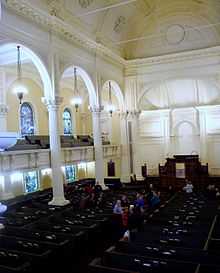Arlington Street Church
|
Arlington Street Church | |
 | |
|
Arlington St. Church, c. 1862. Photo by J.J. Hawes | |
 | |
| Location | 351-355 Boylston Street, Boston, Massachusetts |
|---|---|
| Coordinates | 42°20′0″N 71°2′30″W / 42.33333°N 71.04167°WCoordinates: 42°20′0″N 71°2′30″W / 42.33333°N 71.04167°W |
| Area | 0.5 acres (0.20 ha) |
| Built | 1861 |
| Architectural style | Other, 18th-century English |
| Governing body | Private |
| Part of | Back Bay Historic District (#73001948) |
| NRHP Reference # | 73000313[1] |
| Significant dates | |
| Added to NRHP | May 4, 1973 |
| Designated CP | August 14, 1973 |
The Arlington Street Church is a Unitarian Universalist church across from the Public Garden in Boston, Massachusetts. Because of its geographic prominence and the notable ministers who have served the congregation, the church is considered to be among the most important in American Unitarianism. Completed in 1861, it was designed by Arthur Gilman and Gridley James Fox Bryant to resemble James Gibbs' St. Martin-in-the-Fields in London.
The congregation was founded in 1729 as the "Church of the Presbyterian Strangers" and became independent in 1787, incorporating under a congregational model of polity. Until the Back Bay location was completed, the congregation was located in the Federal Street Church in downtown Boston, where William Ellery Channing, the first major American Unitarian minister, preached from 1803 to 1842. Two future presidents of the American Unitarian Association—Samuel Eliot and Dana Greeley—served the church during its first hundred years in the Arlington Street building. In 1935, the Second Universalist Church of Boston merged its assets with Arlington Street Church. In so doing, Arlington Street Church inherited the thinking of two great liberal theologians: Channing, called "the father of American Unitarianism," and Hosea Ballou, called "the father of American Universalism."
On May 17, 2004, the Arlington Street Church was the site of the first state-sanctioned same-sex marriage in the United States.[2]
Arlington Street church building

As the population of Boston grew and land became scarce, landfills were created in the North End, South End, and finally the Back Bay during the 1850s. When the area around Federal Street became commercial, the congregation adventurously voted to move to the Back Bay. Arlington Street Church was the first public building to be constructed on the newly filled land. The present building was begun in 1859 and dedicated in 1861. Designed by Arthur Gilman and Gridley James Fox Bryant, architects for the Old Boston City Hall, its exterior was inspired by St. Martin-in-the-Fields, London.[3] The building is supported by 999 wooden pilings driven into the mud of Back Bay, and brownstone for its exterior was quarried in New Jersey. The bell tower stands 190 feet (58 meters) tall and contains a set of 16 bells, each with a Biblical inscription. It is one of only four sets in the city of Boston still rung by hand. The building was listed on the National Register of Historic Places in 1973.[1]
Interior

The sanctuary, with its Corinthian columns and graceful rounded arches, was modeled after the Basilica della Santissima Annunziata del Vastato in Genoa, Italy. The panels on either side of the choir loft, containing the Ten Commandments and the Lord’s Prayer, were brought from the Federal Street Church, as was Dr. William Ellery Channing’s pulpit, which stands in the Hunnewell Chapel. The box pews, made of chestnut with black walnut rails, were at one time deeded to members of the congregation. Enclosing each pew signified that they were privately owned and kept drafts from blowing in from the aisles.
Originally, all of the sanctuary windows contained clear glass. In 1898 the congregation voted to install memorial stained glass windows created by the studios of Louis C. Tiffany. The last of the 16 windows was installed in 1930. The church archives contain designs for the four windows that were never installed, because the Tiffany Studios was liquidated in 1937 and thereafter new Tiffany windows were unobtainable.
The Aeolian-Skinner organ was installed in 1957.
Governance and association
Arlington Street Church is a member congregation of the Unitarian Universalist Association, a denomination created in 1961 by the consolidation of the American Unitarian Association and the Universalist Church of America. The denomination is organized on the basis of congregational church government. Each congregation is self-governing, deciding on its form of worship, professional and lay leadership, programs, and business. Congregations are members of the Unitarian Universalist Association and are united by a statement of Purposes and Principles. Each congregation elects delegates to a yearly General Assembly where they congregational delegates vote on matters of denominational importance and on resolutions of social witness. Congregations are served by programs provided by the Association at the continental and regional levels.
Gallery
-

Steeple of Arlington Street Church viewed through autumn foliage of the Public Garden
-

Arlington St. Church, 19th-century photo by John P. Soule
-

Arlington Street Church, 2013
See also
- Federal Street Church (Boston)
- National Register of Historic Places listings in northern Boston, Massachusetts
References
- ↑ 1.0 1.1 "National Register Information System". National Register of Historic Places. National Park Service. 2010-07-09.
- ↑ Mehren, Elizabeth (18 May 2004). "Gay Couples Tie the Knot in Massachusetts". Los Angeles Times. Retrieved 20 April 2015.
- ↑ "MACRIS inventory record for Arlington Street Church". Commonwealth of Massachusetts. Retrieved 2014-05-30.
External links
| Wikimedia Commons has media related to Arlington Street Church (Boston, Massachusetts). |
- Arlington Street Church official website
- The historical records of and correspondence and collected resources on social and religious movements kept by the Arlington Street Church are in the Andover-Harvard Theological Library at Harvard Divinity School in Cambridge, Massachusetts.
| |||||||||||||||||||||||||||||||||||||||||||||||||||||||

